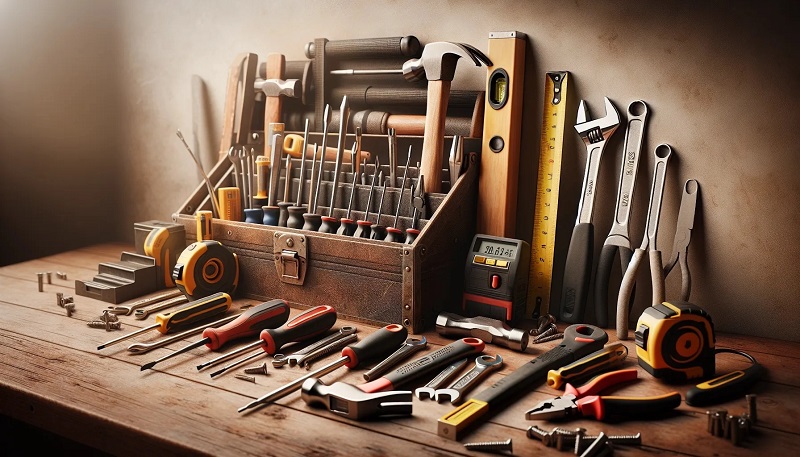
In a world where convenience often trumps craftsmanship, the humble handyman remains a cornerstone of practicality and innovation. While we often admire the results of their work—the neatly fixed cabinets, the perfectly aligned shelves, or the freshly installed plumbing—few take a moment to appreciate the artistry that goes into it. This article delves into the unseen craftsmanship of a true handyman, where the magic happens not just in the hands, but within the tools they wield with mastery: the toolbox.
A true handyman’s toolbox is not merely a collection of hammers, screwdrivers, and pliers. It’s a curated set of instruments, each chosen for its specific function and intricately honed to serve a particular need. It is a symbol of preparedness, versatility, and knowledge. Just like a chef knows the precise knife for each task in the kitchen, a handyman knows which tool will provide the best results for any job. This tool knowledge isn’t something that can be learned overnight. It’s the result of years of experience, trial and error, and an inherent understanding of how the physical world works.
A true craftsman doesn’t just look at a task as a job to be done but as a puzzle to be solved. They understand the nuances of materials, the importance of angles, the way wood reacts to heat, or how the right screw can make or break a structure. Every measurement is calculated with precision, every decision considered thoughtfully. This type of meticulousness is what distinguishes a good handyman from a great one. It’s about creating solutions that not only work but last. Similarly, with metalwork, they recognize the importance of proper welding techniques and the right type of metal for the task at hand. It’s this intricate knowledge of the materials combined with their tools that allows them to craft solutions that are far beyond what the average person would consider.
For example, when a Handyman Huston repairs a leaking pipe, they don’t just slap a patch on it. They consider the type of pipe, the pressure it’s under, and how best to approach the repair so that it withstands the test of time. The handyman’s choice of tools for this task, whether it’s a pipe cutter, wrench, or a soldering iron, is an art form in itself. The way they handle these tools reveals years of practice, and the way they apply that knowledge to make the perfect fix is true wizardry.
Beyond physical tools, a true handyman brings an invisible set of tools to the table: their intuition, resourcefulness, and adaptability. These aren’t things you can find in a toolbox, yet they are equally crucial to the success of the job. For instance, a handyman may encounter a problem that doesn’t have an immediate, obvious solution. It’s in these moments where experience and creativity shine. They might need to repurpose a tool, combine several methods, or even improvise using unconventional materials. This resourcefulness is the unseen craftsmanship that elevates their work from functional to exceptional.
Moreover, a true handyman doesn’t just fix things; they make them better. In every repair or improvement, there’s an underlying principle of refinement. Whether it’s smoothing a rough edge, ensuring a perfect fit, or enhancing the efficiency of a system, the work of a skilled craftsman always involves elevating the original design to something even more practical and enduring.
Toolbox wizardry is, at its core, about understanding how things come together and how they can be transformed. It’s about finding joy in the process of creation, repair, and refinement—transforming an everyday task into an expression of craftsmanship. While much of a handyman’s work is unseen, the results are felt in the sturdiness of the work they leave behind, providing functionality, durability, and beauty in unexpected places. And when done right, the unseen craftsmanship of a true handyman can truly be considered magical.
In a world driven by technology and convenience, the art of craftsmanship often goes unnoticed. Yet, behind every smoothly functioning home, every sturdy piece of furniture, and every well-maintained space stands a true handyman—an unsung hero equipped not only with tools but with the expertise, intuition, and ingenuity to tackle any challenge. The magic of a handyman lies not in the tools themselves but in the way they are wielded with skill, creativity, and precision. This is the unseen craftsmanship that defines the true handyman—what we call “Toolbox Wizardry.”
The Art of Mastering the Toolbox
A toolbox is not just a collection of tools; it is an extension of a handyman’s hands, a vault of solutions, and a testament to experience. Every tool has a purpose, and a skilled handyman knows precisely when and how to use it. Whether it’s a simple hammer and nails or a sophisticated power drill, the magic is in the mastery.
A true handyman understands that quality tools make a difference. Investing in high-grade equipment ensures durability and precision, but knowing how to maximize their potential is what truly separates the novice from the expert. A screwdriver is not just for driving screws—it can also serve as a pry bar in a pinch. A tape measure is more than a length gauge; it can be a straight edge, a marking guide, or even a makeshift compass.
The Science behind the Craft
While many may see handyman work as purely physical labor, it is, in fact, a science. The physics of force, the mechanics of structures, and the chemistry of materials all play a crucial role in ensuring that every repair, build, or renovation is structurally sound and long-lasting.
For example, understanding the principles of leverage allows a handyman to move heavy objects with minimal effort. Knowing the expansion and contraction properties of different materials ensures that wooden structures don’t warp or crack over time. Even something as simple as selecting the right type of nail for a project involves knowledge of metal properties, material density, and load-bearing capacity.
Problem-Solving with Ingenuity
No two repair jobs are the same, and unexpected problems are part of the game. This is where a handyman’s creativity shines. A true handyman is a natural problem-solver who can think on their feet and come up with innovative solutions when things don’t go as planned.
For instance, imagine fixing a leaky pipe without access to the right replacement parts. Instead of giving up, a skilled handyman might use a temporary epoxy seal, a section of rubber tubing, or even a strategically placed clamp to stop the leak until proper repairs can be made. Improvisation is a key component of toolbox wizardry, allowing a handyman to adapt to any situation and still get the job done efficiently.
The Importance of Precision and Attention to Detail
Handyman work is often about precision. A fraction of an inch can make the difference between a door that swings open smoothly and one that sticks. A minor miscalculation in leveling can result in a crooked shelf or a tilting table. That’s why the best handymen are meticulous in their measurements, cuts, and alignments.
Beyond functionality, aesthetics matter too. A handyman with an eye for detail ensures that screws are flush, paint is evenly applied, and surfaces are perfectly smoothed. These seemingly minor details add up to create a polished, professional finish that enhances the overall appearance and longevity of any project.
Experience and Continuous Learning
Handyman skills are honed over time. No one becomes a master overnight; it takes years of practice, trial and error, and hands-on experience to perfect the craft. However, a true handyman never stops learning. New tools, techniques, and materials are constantly emerging, and staying updated ensures that the quality of work remains top-notch.
Continuous learning can come from various sources, including online tutorials, workshops, on-the-job experience, and even conversations with fellow craftsmen. A good handyman is always open to new ideas and embraces innovation while still valuing traditional craftsmanship.
The Handyman’s Role in Society
A handyman’s work is often taken for granted until something goes wrong. Yet, without their skills, homes would fall into disrepair, appliances would remain broken, and countless DIY enthusiasts would find themselves stuck in frustrating projects. Handymen play a vital role in maintaining the infrastructure of daily life, making homes safer, workplaces more functional, and communities more resilient.
Additionally, their expertise can be a valuable source of empowerment. Many handymen take pride in teaching others, passing down their knowledge to the next generation. Whether it’s mentoring an apprentice, giving DIY tips to homeowners, or offering advice in online forums, their impact extends beyond just fixing things—they help build confidence and capability in others.
The Evolution of Handyman Tools and Techniques
The tools of the trade have evolved significantly over the years. What was once a profession reliant solely on manual labor and traditional tools has now integrated advanced technology and smart devices. Laser levels ensure perfect alignment, power tools cut down project time, and mobile apps assist with measurements, material calculations, and even project planning.
However, while technology has made certain tasks easier, the core of craftsmanship remains unchanged. A true handyman combines the best of both worlds—traditional expertise with modern innovation—to achieve superior results.
